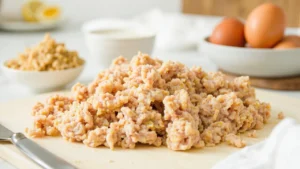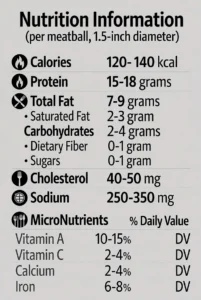Ground Chicken Meatballs Recipe: Healthy, Flavorful, And Easy To Make
Introduction
If you’re looking for a delicious, healthy, and easy-to-make meal, these ground chicken meatballs are the perfect choice. Packed with lean protein, flavor, and simple ingredients, this recipe will quickly become a family favorite. Whether you’re trying to eat healthier, looking for a quick weeknight dinner idea, or simply want to try something new, these ground chicken meatballs are an ideal solution. They’re packed with flavor, easy to make, and perfect for any meal prep!
In this post, we’ll show you how to make these delicious ground chicken meatballs in a few simple steps. We’ll also discuss different variations, tips for making them extra juicy and flavorful, and how you can customize the recipe to suit your taste. Plus, we’ll give you ideas for serving these meatballs as part of a balanced meal or for meal prepping!
These healthy meatballs are made with lean ground chicken, ensuring a lighter version of traditional meatballs. Whether you’re looking to make a low-fat recipe or need a quick and easy meal prep option, this recipe has you covered!
Why Choose Ground Chicken?

This bowl of fresh ground chicken is paired with aromatic herbs like parsley and rosemary, and a bright lemon for added zest, perfect for making flavorful chicken meatballs or other dishes.
In this section, the goal is to highlight the health benefits of using ground chicken in meatball recipes compared to other meat options like beef or pork. You’ll want to appeal to readers who are either health-conscious, looking for lighter meal alternatives, or exploring ways to incorporate more lean protein into their diet.
Here’s a detailed breakdown:
1. Leaner Protein Source
One of the key benefits of ground chicken is that it’s a leaner protein option compared to other meats like beef or pork. Ground chicken is typically lower in total fat and calories, making it an excellent choice for anyone looking to maintain a healthy weight or reduce their intake of saturated fat.
Health Insight: Lean proteins are essential for building muscle, repairing tissues, and keeping your metabolism functioning efficiently. Because chicken has less fat than red meats, it helps you get the necessary protein without the excess calories and fat.
Example:
“Ground chicken is an ideal source of lean protein, containing significantly less fat than beef or pork. Whether you’re looking to maintain a healthy weight, build muscle, or simply eat cleaner, choosing ground chicken will give you the protein your body needs without the extra calories from fat.”
2. Lower in Saturated Fat
Compared to traditional beef or pork, ground chicken has significantly less saturated fat, which can contribute to heart disease and other chronic conditions when consumed in excess. Opting for ground chicken helps to reduce saturated fat intake, which is an important part of a heart-healthy diet.
Health Insight: Reducing saturated fat intake is beneficial for lowering cholesterol levels and reducing the risk of cardiovascular disease. By swapping fatty beef or pork for lean ground chicken, you’re making a heart-healthy choice.
Example:
“With less saturated fat than its red meat counterparts, ground chicken helps to keep your heart healthy and supports good cholesterol levels. This makes it an excellent choice for anyone looking to reduce their cardiovascular risk without sacrificing flavor.”
3. Lower Caloric Content
Ground chicken is naturally lower in calories than many other types of meat. For people who are looking to manage their calorie intake (whether for weight loss or maintenance), ground chicken is a great option because it offers a satisfying meal without the extra calories.
Health Insight: Ground chicken can help you create lighter dishes that are filling and nutritious, making it a fantastic option for meal planning or calorie-conscious diets.
Example:
“Ground chicken offers a lower-calorie alternative to traditional meatballs made from beef or pork. Whether you’re counting calories or simply looking for a lighter meal, ground chicken will fill you up without leaving you feeling heavy.”
4. Versatility and Customization
Ground chicken is incredibly versatile and can be seasoned or flavored in a variety of ways to suit almost any culinary preference. While the flavor is mild on its own, it absorbs herbs, spices, and sauces easily, making it a customizable base for different types of meatballs and other recipes.
Health Insight: The ability to customize the flavor of ground chicken means you can use a variety of healthy ingredients to flavor your dish. You can choose to add fresh herbs, whole grains, vegetables, or even swap out unhealthy oils for healthier fats (like olive oil).
Example:
“Ground chicken is a blank canvas for creating flavorful and healthy dishes. By adding ingredients like garlic, fresh herbs, or healthy fats like olive oil, you can easily control the flavor profile of your meatballs while keeping the dish light and healthy.”
5. Rich in Essential Nutrients
Ground chicken is a good source of several essential nutrients, such as B vitamins (especially niacin and B6), phosphorus, selenium, and iron. These nutrients are crucial for energy production, metabolism, immune function, and muscle development.
Health Insight: By incorporating ground chicken into your diet, you are ensuring a good intake of important nutrients that contribute to overall health and well-being. This makes it not just a low-calorie option, but also a nutrient-dense choice.
Example:
“In addition to being a lean protein, ground chicken is rich in essential vitamins and minerals like B6, phosphorus, and selenium. These nutrients are vital for energy production, muscle health, and immune system support, making ground chicken a smart choice for a well-balanced diet.”
6. Great for Special Diets (Keto, Low-Carb, Gluten-Free)
Ground chicken fits seamlessly into several popular diets, including keto, low-carb, and gluten-free diets. Because it’s low in fat and carbohydrates, it works well for people following these eating patterns without sacrificing flavor or satisfaction.
Health Insight: For those following keto or low-carb diets, ground chicken meatballs are an excellent alternative to traditional higher-carb meatball recipes (which might use breadcrumbs or high-carb fillers).
Example:
“Whether you’re on a low-carb or keto diet, ground chicken is a perfect option. You can make delicious, filling meatballs without worrying about excess carbohydrates, all while sticking to your dietary goals. It’s also naturally gluten-free, making it suitable for a variety of diets.”
7. Environmentally Friendly Choice
Although this isn’t a direct health benefit, choosing chicken over beef or pork can also have a positive impact on the environment. Chicken typically has a smaller environmental footprint in terms of water usage, land requirements, and carbon emissions compared to beef.
Health Insight: Not only is ground chicken better for your health, but it’s also a more sustainable choice for those looking to reduce their environmental impact.
Example:
“Choosing ground chicken isn’t just good for your body; it’s also a more environmentally friendly choice. Chicken production typically uses fewer resources and emits less carbon compared to beef, making it a more sustainable option for those conscious of their environmental footprint.”
Ingredients for Ground Chicken Meatballs

Fresh ground chicken prepared on a cutting board, ready to be combined with ingredients like eggs and breadcrumbs to make flavorful meatballs or other dishes.
1. Ground Chicken
The star of the recipe! Ground chicken is the main protein source, making the meatballs lean and healthy. As we’ve discussed earlier, it’s a low-fat, high-protein option that provides essential nutrients without the extra calories found in beef or pork.
Example:
“Start with ground chicken, the lean protein base for these meatballs. You can use either ground chicken breast for an even leaner option or ground chicken thigh for a slightly juicier texture.”
2. Breadcrumbs (or Alternatives)
Breadcrumbs are commonly used to bind the meatballs together. However, if you’re aiming for a low-carb or gluten-free option, you can substitute breadcrumbs with almond flour or gluten-free breadcrumbs.
Example:
“For the perfect texture, use regular breadcrumbs, but if you’re making gluten-free meatballs, feel free to substitute with almond flour or oats to help bind everything together.”
3. Egg
Eggs are used to bind the ingredients and help hold the meatballs together while cooking. They also contribute to the texture and provide essential vitamins and minerals.
Example:
“The addition of an egg helps bind everything together, ensuring your meatballs don’t fall apart while baking or frying. Plus, eggs are a great source of protein and other nutrients.”
4. Fresh Garlic and Onion
Garlic and onion are essential for adding aromatic flavor to the meatballs. These ingredients elevate the taste and can also provide a variety of health benefits like improved digestion and immune function.
Example:
“For an aromatic flavor profile, incorporate finely chopped fresh garlic and onion. These ingredients not only enhance the taste but also provide a dose of antioxidants and other immune-boosting nutrients.”
5. Fresh Herbs (Parsley, Basil, Oregano)
Herbs add freshness and depth of flavor to your ground chicken meatballs. Parsley and basil are common choices, but you can experiment with oregano, thyme, or rosemary depending on your preferences. Fresh herbs are also packed with antioxidants and have anti-inflammatory properties.
Example:
“Add fresh herbs like parsley and basil to your meatball mixture. These herbs not only add vibrant flavor but are also rich in antioxidants and essential oils that provide anti-inflammatory benefits.”
6. Parmesan Cheese (Optional)
Parmesan cheese adds a savory umami flavor to the meatballs, making them extra tasty. You can use freshly grated Parmesan for the best flavor, but feel free to use Parmesan alternatives if you’re dairy-free or looking for a lighter version.
Example:
“For a rich, savory flavor, add freshly grated Parmesan cheese. If you’re following a dairy-free diet, you can easily substitute nutritional yeast for a similar umami taste.”
7. Salt and Pepper (To Taste)
Seasoning your meatballs is essential, and salt and pepper are the basic seasonings. These ingredients help to bring out the natural flavors in the chicken and other ingredients. You can adjust the amount based on your personal preference.
Example:
“Don’t forget to season with salt and pepper to bring out the natural flavors of the chicken and herbs. Adjust to taste for the perfect seasoning balance.”
8. Olive Oil (For Cooking or Baking)
A small amount of olive oil is great for adding moisture and richness to the meatballs. If you’re baking the meatballs, a light drizzle or brushing with olive oil will help achieve a golden, crispy exterior.
Example:
“A light drizzle of olive oil is perfect for baking these meatballs. It helps keep them moist while giving them a beautiful, golden crisp. Plus, olive oil is a healthy fat that complements the lean ground chicken.”
9. Optional: Crushed Red Pepper Flakes
If you like a little heat, you can add crushed red pepper flakes to the meatball mixture. This adds a mild spice without overpowering the flavor, giving the meatballs an extra kick.
Example:
“For those who like a little extra heat, adding a pinch of crushed red pepper flakes to the mixture will give your meatballs a subtle spicy kick.”
How to Make Ground Chicken Meatballs

Fresh ground chicken is ready to be mixed with breadcrumbs, eggs, and herbs for homemade meatballs, with a focus on wholesome, healthy ingredients.
Making ground chicken meatballs is a simple process that results in a healthy and flavorful dish. Below, I’ve broken down the steps into clear, easy-to-follow instructions. Additionally, I’ll highlight key tips and offer guidance on different cooking methods, so you can get the most out of your meatballs.
1. Prepare the Ingredients
Before you start making the meatballs, it’s important to have all your ingredients ready. This makes the process smoother and faster.
Gather your ingredients: You’ll need ground chicken, breadcrumbs, eggs, garlic, onion, fresh herbs, Parmesan cheese (optional), salt, pepper, and any other optional seasonings or spices.
Tip: If you’re using ground chicken breast, be aware that it might be a little drier than ground thigh meat. You can compensate by adding an extra splash of olive oil or adjusting the breadcrumbs to maintain moisture.
2. Forming the Meatballs
Once you have all your ingredients prepped, it’s time to mix everything together and form the meatballs. This step is crucial to ensure they hold together during cooking.
Combine the ingredients: In a large mixing bowl, combine the ground chicken, breadcrumbs, egg, garlic, onion, herbs, and Parmesan cheese (if using). Season with salt and pepper.
Mix gently: Use your hands or a spoon to mix everything together, but be careful not to overmix. Overmixing can result in tough meatballs. The mixture should be firm but moist, so it holds together when you form the meatballs.
Form the meatballs: Take a small amount of the mixture and roll it into a ball, about the size of a golf ball (roughly 1 to 1.5 inches in diameter). If the mixture feels too sticky, lightly wet your hands with water to prevent sticking.
Tip: If you want uniform-sized meatballs, you can use a cookie scoop or an ice cream scoop to portion out the mixture evenly.
3. Baking vs. Frying
One of the most important decisions when making meatballs is choosing the cooking method. Both baking and frying have their benefits, and I’ll walk you through both methods so you can choose what works best for you.
Baking the Meatballs (Healthier Option)
Preheat your oven: Set your oven to 375°F (190°C). This temperature allows the meatballs to cook evenly without burning.
Prepare the baking sheet: Line a baking sheet with parchment paper or lightly grease it with olive oil to prevent sticking.
Arrange the meatballs: Place your formed meatballs on the prepared baking sheet, spacing them about 1-2 inches apart to ensure even cooking.
Bake: Bake for 20-25 minutes or until the meatballs are golden brown on the outside and cooked through (internal temperature of 165°F or 75°C).
Tip: If you prefer a crispier exterior, you can broil the meatballs for the last 2-3 minutes of baking, keeping a close eye on them to avoid burning.
Frying the Meatballs (Crispy Option)
Heat a skillet: In a large skillet, heat 2-3 tablespoons of olive oil over medium heat. You want enough oil to cover the bottom of the pan for frying.
Fry the meatballs: Add the meatballs to the pan, being careful not to overcrowd the pan. Fry for about 4-5 minutes per side, turning occasionally, until they are golden brown and cooked through. You can check the internal temperature with a meat thermometer to ensure it reaches 165°F (75°C).
Drain excess oil: Once cooked, transfer the meatballs to a paper towel-lined plate to drain any excess oil.
Tip: If you’re frying multiple batches, be sure to wipe down the pan with a paper towel and add more oil between batches to keep the frying process even.
4. Tips for Flavorful Meatballs
To ensure your ground chicken meatballs are flavorful and tender, here are some helpful tips that will elevate the taste and texture:
Don’t overmix the meatball mixture: As mentioned earlier, overmixing can lead to dense, tough meatballs. Gently combine all the ingredients to preserve the texture.
Let the meatballs rest: After forming the meatballs, let them rest for about 10-15 minutes before cooking. This helps the flavors meld together and ensures they stay intact during cooking.
Add extra herbs and spices: If you want to customize your meatballs, feel free to add extra seasonings like garlic powder, onion powder, or oregano. Fresh herbs like basil or thyme can also provide a flavorful twist.
Moisture is key: Ground chicken can dry out quickly, so consider adding olive oil, tomato paste, or even a splash of milk to the mixture to ensure they remain moist and tender.
Rest the meatballs after cooking: Once you remove the meatballs from the oven or skillet, let them rest for a few minutes. This helps redistribute the juices inside and keeps them moist.
Tip: If you’re making meatballs for meal prep or a crowd, consider batch cooking—make a large batch and freeze some for later use. This way, you’ll always have healthy, homemade meatballs on hand.
Serving Suggestions for Ground Chicken Meatballs

Juicy ground chicken meatballs served with a side of perfectly roasted carrots, zucchini, and peppers, offering a healthy and flavorful meal.
Now that you’ve got your delicious and healthy ground chicken meatballs, it’s time to pair them with sides that will complement their flavor and texture while keeping your meal balanced. Whether you’re looking for low-carb options, vegetable-based sides, or a more indulgent accompaniment, here are some fantastic side dish ideas to serve with your meatballs.
1. Roasted Vegetables
Roasted vegetables are a perfect side dish for ground chicken meatballs. They’re simple to make, incredibly nutritious, and bring a burst of color and flavor to your plate.
Vegetable Suggestions: Carrots, zucchini, bell peppers, Brussels sprouts, sweet potatoes, and cauliflower are all excellent options.
Health Benefit: Roasting veggies caramelizes their natural sugars, enhancing their sweetness and flavor. Plus, they provide fiber, vitamins, and minerals to make your meal even more nutritious.
How to Serve: Toss the vegetables in olive oil, salt, and pepper (you can add garlic and herbs like rosemary or thyme for extra flavor) and roast them in the oven at 400°F (200°C) for about 20-25 minutes.
Example:
“Pair your ground chicken meatballs with a mix of roasted vegetables like Brussels sprouts, sweet potatoes, and bell peppers for a flavorful and fiber-rich side dish.”
2. Cauliflower Rice (Low-Carb Option)
For those following a low-carb or keto diet, cauliflower rice is a fantastic, nutrient-packed alternative to regular rice or pasta. It has a mild flavor and absorbs the sauce from the meatballs beautifully.
Health Benefit: Cauliflower is low in carbohydrates and high in fiber and vitamins, making it an excellent choice for anyone watching their carb intake while still getting essential nutrients.
How to Serve: You can either buy pre-made cauliflower rice or make your own by pulsing cauliflower florets in a food processor until they resemble rice. Sauté with a little olive oil and garlic for extra flavor.
Example:
“For a low-carb option, serve your ground chicken meatballs with sautéed cauliflower rice. It’s a great way to keep the meal light while still enjoying a satisfying texture.”
3. Zucchini Noodles (Zoodles)
Another excellent low-carb and vegetable-based option is zucchini noodles, commonly known as zoodles. These are a great alternative to traditional pasta and pair beautifully with chicken meatballs, especially if you’re serving them with a tomato sauce.
Health Benefit: Zucchini noodles are rich in water and low in calories, making them a great option for weight management and hydration.
How to Serve: Use a spiralizer to create zoodles and sauté them lightly in olive oil until they’re tender but still have a little bite. You can serve them with your chicken meatballs and a drizzle of your favorite sauce or as a base for meatballs.
Example:
“For a low-carb pasta alternative, serve your chicken meatballs on a bed of fresh zucchini noodles (zoodles). Lightly sautéed with a touch of olive oil, they offer a satisfying, veggie-packed base for the meatballs.”
4. Quinoa Salad
If you’re looking for a high-protein and fiber-rich side, a quinoa salad is a perfect choice. Quinoa is a complete protein, meaning it contains all nine essential amino acids, making it a great complement to the lean protein in ground chicken meatballs.
Health Benefit: Quinoa is packed with protein, fiber, and antioxidants, and it’s a fantastic source of minerals like magnesium and iron. It’s also gluten-free, making it suitable for various dietary needs.
How to Serve: Prepare quinoa according to package directions, then toss with fresh veggies (such as cherry tomatoes, cucumbers, and red onion), a squeeze of lemon, and a drizzle of olive oil for a light, refreshing side.
Example:
“For a protein-packed side, serve your ground chicken meatballs with a vibrant quinoa salad, loaded with fresh vegetables and a light lemon vinaigrette.”
5. Steamed Green Beans with Almonds
Green beans are another great side dish that pairs wonderfully with chicken meatballs. They’re simple to prepare, delicious, and offer a nice crunch alongside the tender meatballs.
Health Benefit: Green beans are rich in vitamins like vitamin C and vitamin K, and they’re a good source of folate and fiber, which support immune function and digestive health.
How to Serve: Steam or blanch the green beans until they’re just tender, then toss them with a little olive oil, lemon juice, and toasted almonds for a touch of crunch.
Example:
“Pair your ground chicken meatballs with steamed green beans and a sprinkle of toasted almonds for a crunchy, nutrient-packed side that adds both texture and flavor.”
6. Greek Salad
A Greek salad is another excellent option if you’re looking for something light, refreshing, and full of flavor. The tangy feta cheese, olives, and cucumbers complement the savory flavor of the meatballs perfectly.
Health Benefit: Greek salads are packed with healthy fats from olive oil and feta cheese, as well as antioxidant-rich vegetables, making them a great heart-healthy option.
How to Serve: Combine chopped cucumbers, tomatoes, red onion, Kalamata olives, and a generous amount of feta cheese. Dress with olive oil, lemon juice, and oregano for that authentic Greek flavor.
Example:
“For a refreshing and flavorful side, pair your chicken meatballs with a Greek salad featuring cucumbers, tomatoes, Kalamata olives, and feta cheese.”
7. Sweet Potato Fries
For a more indulgent side dish that still offers nutritional benefits, sweet potato fries are a great choice. They provide a natural sweetness that balances well with the savory flavor of the chicken meatballs.
Health Benefit: Sweet potatoes are rich in vitamin A and beta-carotene, which support eye health, and they also provide a good amount of fiber and antioxidants.
How to Serve: Slice sweet potatoes into fries, toss with olive oil and seasonings, and bake at 425°F (220°C) for about 20-30 minutes, flipping halfway through until crispy.
Example:
“For a heartier side, serve your chicken meatballs with crispy baked sweet potato fries. They’re packed with vitamin A and are the perfect balance to the lean meatballs.”
Nutritional Information for Ground Chicken Meatballs

Detailed nutrition information for ground chicken meatballs, providing breakdowns of calories, protein, fat, and essential vitamins and minerals per meatball.
The nutritional breakdown of your ground chicken meatballs will vary depending on the specific ingredients you use, but here’s a general breakdown based on a standard recipe using lean ground chicken and healthy ingredients.
This information provides an estimate per meatball (based on a recipe making 12-14 meatballs, each about 1.5 inches in diameter). For those on specific diets, like keto, low-carb, or high-protein, this section can help them track their macros and stay within their goals.
Estimated Nutritional Values per Ground Chicken Meatball (1 Meatball, 1.5-inch diameter):
Calories: 120-140 kcal
Protein: 15-18 grams
Fat: 7-9 grams
Saturated Fat: 2-3 grams
Carbohydrates: 2-4 grams
Fiber: 0-1 gram
Sugars: 0-1 gram
Cholesterol: 40-50 mg
Sodium: 250-350 mg
Vitamin A: 10-15% of Daily Value
Vitamin C: 2-4% of Daily Value
Calcium: 2-4% of Daily Value
Iron: 6-8% of Daily Value
Breaking Down the Nutrients:
1. Calories:
Each ground chicken meatball typically contains between 120-140 calories, depending on the exact portion sizes and ingredients used. This makes them a low-calorie option compared to traditional beef or pork meatballs, which can be more calorie-dense. If you’re looking for a meal that satisfies without overloading on calories, these meatballs are an excellent choice.
Tip: For a lower-calorie meal, try serving these meatballs with lighter sides, such as cauliflower rice or a green salad, to keep the total calorie count lower.
2. Protein:
One of the key benefits of ground chicken meatballs is their high protein content. A typical meatball contains around 15-18 grams of protein. This is great for muscle repair, keeping you full longer, and supporting overall body functions.
Tip: If you’re on a high-protein diet or looking to build muscle, these meatballs are an excellent option. Pair them with high-protein sides like quinoa or a Greek yogurt-based dip to further boost your protein intake.
3. Fat:
Each meatball typically has 7-9 grams of fat, including about 2-3 grams of saturated fat. While this is still a moderate amount of fat, the fat in ground chicken is much lower compared to fatty cuts of beef or pork.
Healthy Fats: Most of the fat in the meatballs will come from olive oil (if used), Parmesan cheese, and the natural fat content in the ground chicken. These fats are generally healthier than the saturated fats found in traditional meatballs made with fattier meats.
Tip: If you’re looking to lower the fat content, you can opt for extra-lean ground chicken or skinless chicken breast. Additionally, skipping or reducing the amount of cheese can help reduce the fat content.
4. Carbohydrates:
Ground chicken meatballs are typically very low in carbohydrates, containing about 2-4 grams of carbs per meatball. Most of these carbs will come from breadcrumbs (if using), which provide structure and texture. If you’re making a low-carb or keto-friendly version, you can substitute breadcrumbs with almond flour, coconut flour, or parmesan cheese to make them virtually carb-free.
Fiber: Depending on the ingredients, these meatballs may contain a small amount of fiber (0-1 gram). Fiber is crucial for digestion and maintaining stable blood sugar levels.
Tip: To keep the carb count low, consider using gluten-free breadcrumbs or almond flour. You can also serve your meatballs with zucchini noodles or cauliflower rice to maintain a low-carb meal.
5. Cholesterol:
Given that ground chicken is lean, each meatball contains approximately 40-50 mg of cholesterol. This is significantly lower than beef or pork meatballs, which tend to have higher cholesterol levels.
Tip: If you’re concerned about cholesterol, using skinless ground chicken breast will reduce the cholesterol content even further.
6. Sodium:
The sodium content of your meatballs will largely depend on how much salt you add and if you’re using Parmesan cheese or other salty ingredients like breadcrumbs. A standard meatball will have about 250-350 mg of sodium per serving.
Tip: For those watching their sodium intake, consider reducing the salt or using low-sodium breadcrumbs or Parmesan cheese. You can also experiment with seasoning with herbs and spices like oregano, garlic powder, or onion powder to enhance flavor without adding extra salt.
7. Vitamins and Minerals:
Vitamin A: These meatballs provide about 10-15% of the daily recommended value for Vitamin A, primarily from fresh herbs (like parsley and basil) and Parmesan cheese. Vitamin A is essential for good vision, immune function, and skin health.
Vitamin C: While not a high source of Vitamin C, these meatballs will provide about 2-4% of the daily value, especially if you pair them with a side of roasted vegetables or a fresh salad.
Calcium: If you add Parmesan cheese, your meatballs will contain calcium, which is necessary for bone health. You can expect about 2-4% of your daily calcium intake per serving.
Iron: Chicken provides a moderate amount of iron (around 6-8% of the daily value). Iron is essential for the production of hemoglobin and oxygen transport in the blood.
How to Adjust the Nutritional Breakdown:
Depending on your dietary needs or personal preferences, here are some ways to modify the recipe to make it more tailored to specific nutrition goals:
For lower fat: Use extra-lean ground chicken or skinless chicken breast to reduce fat and cholesterol content.
For a higher protein boost: Add egg whites instead of whole eggs, or increase the amount of Parmesan cheese (while monitoring fat content).
For low-carb/keto: Swap breadcrumbs for almond flour, coconut flour, or parmesan cheese. Pair the meatballs with low-carb sides like cauliflower rice or zoodles.
For higher fiber: Add ground flaxseed or chia seeds to the meatball mixture for an additional fiber boost.
Conclusion
In conclusion, ground chicken meatballs are a fantastic, healthy, and versatile meal option. Not only are they leaner and lower in calories compared to traditional meatballs made with beef or pork, but they’re also packed with protein and can easily fit into a variety of diets, including low-carb, keto, and gluten-free.
To recap:
Ground chicken meatballs are quick and easy to make, requiring just a few simple ingredients like ground chicken, breadcrumbs (or substitutions like almond flour), fresh herbs, and egg.
You can choose between baking or frying these meatballs, with baking being the healthier option.
These meatballs pair perfectly with a wide range of side dishes, from roasted vegetables to zucchini noodles or even cauliflower rice.
The recipe is customizable with different seasonings, and they can even be made in advance, making them a great choice for meal prep or a quick weeknight dinner.
Don’t forget about the freezing option! Whether you bake or fry them, these meatballs can be easily stored for future use.
So why wait? Try making these ground chicken meatballs tonight—they’re bound to become a new favorite for you and your family. Feel free to experiment with different seasonings, sauces, and sides to make them your own. Whether you’re serving them on their own, as part of a bigger meal, or prepping them for the week, these meatballs are a healthy, delicious, and satisfying option that everyone will love.
Don’t forget to comment below if you tried the recipe or have any tips and variations to share. We’d love to hear how you’re enjoying your ground chicken meatballs!
You can link to authoritative resources on the nutritional benefits of ground chicken, or detailed nutritional databases:



Comment (1)